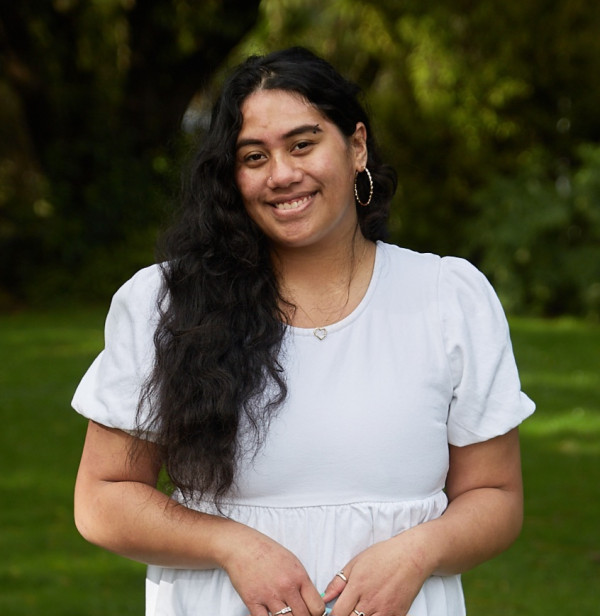Kate Scott loves being in the sun but is only allowed 30 minutes of sunlight every day.
Kate has lupus, an autoimmune condition that makes their immune system attack its own healthy tissues.
Lupus affects muscles and joints, and manifests for Kate in the form of body pain and photosensitivity, also known as sun allergies.
Staying in the sun for longer than that can make the 26 year old’s skin feel like it's “on fire” and give them a fever, hot or cold sweats, migraines, fatigue, skin reactions and heat stroke symptoms.
“It's hard to describe because it's an unseen condition, unless you show visible reactions like I do,” Kate says.
Kate also has fibromyalgia, a chronic pain disorder that affects their bones, joints and muscles.

Kate Scott, 26, has lupus which makes them severely sensitive to the sun. Photo: supplied
Kate has to take Plaquenil every day, a medication that helps people with lupus manage their immune system.
They say they think lupus makes them sensitive to the sun and taking Plaquenil makes it worse.
For Kate, photosensitivity symptoms take a few hours after sun exposure to appear and last a day.
Resting the day after is crucial to Kate as they say their body needs time to heal.
Having a healthy diet, drinking water regularly and sleeping lots are simple but effective ways to manage symptoms for themself, Kate says.
Photosensitivity impacts Kate’s work, mental health and social life
Before being diagnosed with lupus, Kate worked in gardens and orchards in Hawke’s Bay where they spent a lot of time outside.
Kate has now transitioned to only taking indoor jobs and says they have generally adjusted their lifestyle to fit their condition.
Enjoying sunlight is a “luxury” for Kate, who says photosensitivity affects their social life too.
Kate says their sun allergies affect their mental health because “not getting enough sun makes me feel like I’m not human”.
To keep themself safe, they try to only meet up with friends in late afternoons or early evenings when the sun is less harsh.
Kate has noticeable fried tissue and hyperpigmentation on their face from skin reactions to the sun.
They get a lot of questions about their appearance and say they can experience low self esteem when meeting new people.
“I just tell them it's scarring from sunburns because I don't feel like constantly educating people about lupus,” Kate says.
Kate is Cook Islands Māori and says most of their “white-passing” friends are always shocked Kate has photosensitivity despite having brown skin.
They say conversations about their condition are never malicious but they do find phrases like “black don’t crack” to be ironic.
Photosensitivity can have ‘debilitating’ impacts on people
Photosensitivity is a generic term encompassing a variety of disorders that make people sensitive to the sun, says Amanda Oakley, an adjunct associate professor at the University of Auckland and the head of the department of dermatology at Te Whatu Ora Waikato.
Photosensitivity can be inherited or acquired, and Oakley says different types have different causes, symptoms and treatments.
Polymorphic light eruption is the most common type of acquired photosensitivity and is more common in women and more common in less sunny countries.
Some types of photosensitivity occur after coming into contact with specific things.
Phytophotodermatitis occurs after coming into contact with certain plants and drug-induced photosensitivity occurs after having an adverse reaction to a drug.
Oakley says photosensitivity can also occur as a side effect of an inflammatory disease, like lupus.
Cutaneous lupus is a type of lupus which affects the skin and can have “debilitating” impacts, she says.
Oakley says she has seen skin diseases impact the quality of life of many of her patients.
“Rates of depression, anxiety, and unemployment are seriously affected,” she says.
Staying indoors and wearing densely woven clothing that covers the whole body are some prevention methods Oakley recommends.
She says broad-spectrum sunscreen can help prevent photosensitivity symptoms but isn’t always fully effective.
“Makeup can actually be more effective than sunscreen because it is coloured and covers the skin.”
For some rare but severe photosensitivities, Oakley says patients can get special film to cover their home and car windows, and people can get special masks to protect their face from UV burns.
While Oakley says Kate’s symptoms lean on the severe side, Kate says they still love going to beaches and parks.
Lathering on sunscreen and wearing hats – despite “not being a big hat person” – are some of the ways Kate stays safe enough to enjoy the outside world.
“It’s really nice to get outdoors… I do have to be really careful, but I can enjoy myself.”
Where to get help:
- 1737: The nationwide, 24/7 mental health support line. Call or text 1737 to speak to a trained counsellor.
- Suicide Crisis Line: Free call 0508 TAUTOKO or 0508 828 865. Nationwide 24/7 support line operated by experienced counsellors with advanced suicide prevention training.
- Youthline: Free call 0800 376 633, free text 234. Nationwide service focused on supporting young people.
- OUTLine NZ: Freephone 0800 OUTLINE (0800 688 5463). National service that helps LGBTIQ+ New Zealanders access support, information and a sense of community.
More stories:
Do brown people need to wear sunscreen?
Different skin tones have different burn times
How much sun protection do SPF makeup products give you
When it comes to protecting your skin from harmful UV rays from the sun, sunscreen is key.
No one had ever spoken to me about miscarriage. I’m talking about mine
"The loss of a pregnancy is the loss of a dream," writes Ataria Sharman.